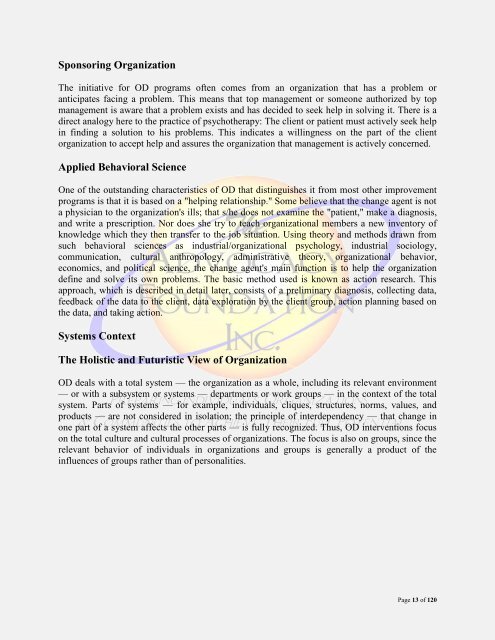Organizational Development - Vol. V, Part II
Organizational Development - Vol. V, Part II
Organizational Development - Vol. V, Part II
Create successful ePaper yourself
Turn your PDF publications into a flip-book with our unique Google optimized e-Paper software.
Sponsoring Organization<br />
The initiative for OD programs often comes from an organization that has a problem or<br />
anticipates facing a problem. This means that top management or someone authorized by top<br />
management is aware that a problem exists and has decided to seek help in solving it. There is a<br />
direct analogy here to the practice of psychotherapy: The client or patient must actively seek help<br />
in finding a solution to his problems. This indicates a willingness on the part of the client<br />
organization to accept help and assures the organization that management is actively concerned.<br />
Applied Behavioral Science<br />
One of the outstanding characteristics of OD that distinguishes it from most other improvement<br />
programs is that it is based on a "helping relationship." Some believe that the change agent is not<br />
a physician to the organization's ills; that s/he does not examine the "patient," make a diagnosis,<br />
and write a prescription. Nor does she try to teach organizational members a new inventory of<br />
knowledge which they then transfer to the job situation. Using theory and methods drawn from<br />
such behavioral sciences as industrial/organizational psychology, industrial sociology,<br />
communication, cultural anthropology, administrative theory, organizational behavior,<br />
economics, and political science, the change agent's main function is to help the organization<br />
define and solve its own problems. The basic method used is known as action research. This<br />
approach, which is described in detail later, consists of a preliminary diagnosis, collecting data,<br />
feedback of the data to the client, data exploration by the client group, action planning based on<br />
the data, and taking action.<br />
Systems Context<br />
The Holistic and Futuristic View of Organization<br />
OD deals with a total system — the organization as a whole, including its relevant environment<br />
— or with a subsystem or systems — departments or work groups — in the context of the total<br />
system. <strong>Part</strong>s of systems — for example, individuals, cliques, structures, norms, values, and<br />
products — are not considered in isolation; the principle of interdependency — that change in<br />
one part of a system affects the other parts — is fully recognized. Thus, OD interventions focus<br />
on the total culture and cultural processes of organizations. The focus is also on groups, since the<br />
relevant behavior of individuals in organizations and groups is generally a product of the<br />
influences of groups rather than of personalities.<br />
Page 13 of 120

















